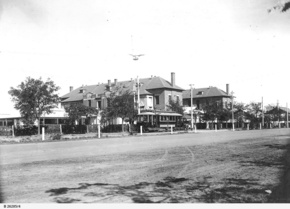
57195
FISHER, Leonard Chesterfield
| Service Number: | 3746 |
|---|---|
| Enlisted: | 11 August 1915, at Adelaide |
| Last Rank: | Private |
| Last Unit: | 10th Infantry Battalion |
| Born: | London, England, March 1887 |
| Home Town: | Glenelg, Holdfast Bay, South Australia |
| Schooling: | Not yet discovered |
| Occupation: | Grocer |
| Memorials: |
World War 1 Service
| 11 Aug 1915: | Enlisted AIF WW1, Private, 3746, 10th Infantry Battalion, at Adelaide | |
|---|---|---|
| 2 Dec 1915: | Involvement Private, 3746, 10th Infantry Battalion, --- :embarkation_roll: roll_number: '10' embarkation_place: Adelaide embarkation_ship: RMS Malwa embarkation_ship_number: '' public_note: '' | |
| 2 Dec 1915: | Embarked Private, 3746, 10th Infantry Battalion, RMS Malwa, Adelaide | |
| 24 Apr 1918: | Wounded AIF WW1, Private, 3746, 10th Infantry Battalion, German Spring Offensive 1918, GSW leg (amputated) |
Help us honour Leonard Chesterfield Fisher's service by contributing information, stories, and images so that they can be preserved for future generations.
Add my storyBiography contributed by St Ignatius' College
Leonard Chesterfield Fisher was born in London, England and grew up in Adelaide, South Australia. His mother lived at 8 Fairholm Road, Kensington, London W, England. He was a part of the Church of England. At the time of his embarkation for war, Leonard Chesterfield Fisher measured 5’8”, weighed 82kg and had a chest measurement of 86cm. He had brown eyes, dark hair and a medium complexion. On arriving in Adelaide, Leonard became a grocer who sold fruit and vegetable produce at Glenelg. He had a friend named Arthur Warren who lived in Parkside, Adelaide. Leonard Chesterfield Fisher enlisted on the 11th of August 1915, becoming a member of the 10th Battalion in the Australian Imperial Force. He was ranked as a private, serving on the front line with the 9th, 10th, 11th and 12threinforcements as a part of the 10th Battalion. Leaving no wife, children, or family behind, Leonard Chesterfield Fisher embarked on the RMS Malwa on the 2nd of December 1915 from Adelaide, Australia. He arrived with the 10th Battalion in Egypt, and in March 1916, he sailed for France and the Western Front. He served with his unit until the 26th of December 1916. Leonard Chesterfield Fisher was charged while on active service, when he quit a working party on the front line without permission from a commanding officer.
Leonard then fell sick on the 27th of January 1917. After 8 months in hospital, on the 30th of September 1917, he re-joined the 10th Battalion in Belgium to take part in the major British offensive, the Third Battle of Ypres. The 3rd Brigade moved at 2 am from their camp situated at Neuve Eglise towards the enemy situated at Chateau Segard. They arrived at 12pm and defeated the enemy, taking the land they held and their resources. On the 15th of February 1918, Leonard Chesterfield Fisher was found guilty of deserting His Majesty's Service. He was sentenced with 5 years of penal servitude, a sentence which was later suspended. Leonard was returned to front line service.
In March 1918, the 10th Battalion helped stop the German spring offensive and was involved in the operation leading up to the Allied counterstroke. On the 24th April Leonard Chesterfield Fisher was wounded in his right leg which fractured his right tibia and fibula. This resulted in his leg being amputated. In March 1919 embarked to return to Australia. Leonard was supplied with an artificial leg and spent 1 year recovering in Keswick Hospital, Adelaide. He was discharged on the 7th of August 1920 from Keswick Hospital and returned home at 5 Sussex Street, Glenelg.
Leonard Chesterfield was awarded the Star Medal, British War Medal, and the Victory Medal. The Star Medal symbolises his service from 1914-1915, the British War Medal is given to soldiers who survived or died during WWI, and the Victory Medal commemorates the victory of the Allied Forces over the Central Powers.












